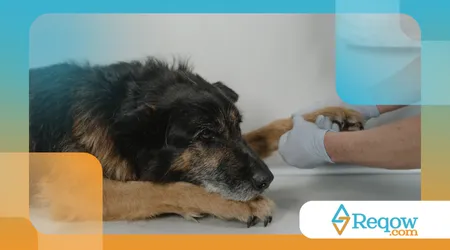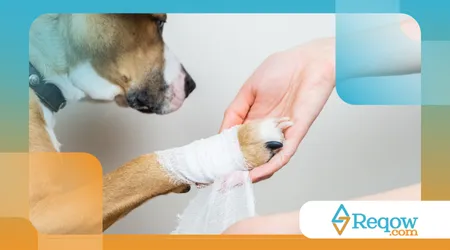Paw Care Routine: Preventing Cracks and Wounds

THE paw care routine is a fundamental pillar to guarantee the well-being and health of your four-legged companion.
Advertisements
Your pet is an endless source of joy and adventure, but have you been paying enough attention to one of its most important pillars of support? More than just a matter of aesthetics, paw care is crucial to preventing pain, discomfort, and health problems that can affect your pet's quality of life.
Dogs' and cats' paws are like our own feet: complex and sensitive structures that face a wide variety of terrains and temperatures every day.
Hot summer asphalt, uneven ground, sharp rocks, and even prolonged exposure to moisture can all cause injuries.
Imagine, for a moment, walking barefoot down the street, with all its irregularities.
Advertisements
This is your pet's reality. That's why, as responsible pet owners, we need to go beyond the obvious.
The anatomy of the paws: a fortress to be protected
Our pets' paws are true works of biological engineering.
They are made up of cushions, which act as natural shock absorbers, and nails, which help with traction and balance.
These cushions are more than just pillows: they are fatty and elastic tissues that protect joints and bones from impact.
The skin of the paw pads is thicker and more resilient, but it's not invulnerable. It can dry out, crack, and become damaged, especially when exposed to extreme conditions.
Neglect can lead to a range of problems, from small cracks that cause pain and sensitivity to more serious bacterial and fungal infections.
Read more: What to look for in your pet's feces to know if their health is okay
An injured paw can make it difficult for an animal to move, directly impacting its ability to play and exercise.
A dog that experiences pain when walking tends to become more sedentary, and this can lead to weight and even behavioral problems.
The step by step of paw care routine
One paw care routine Effective doesn't have to be complicated or time-consuming. In fact, consistency is key.
Below, we've detailed the essential steps you can incorporate into your pet's daily routine. Remember, prevention is always the best medicine.
Daily cleaning and visual inspection
After walks, it's essential to clean your pet's paws. Use a soft, damp cloth or pet-specific wipes.
This cleaning removes dirt, dust, chemicals, and potential irritants that may have become embedded in the pads.
During cleaning, take the opportunity to do a complete visual inspection.
Check for cuts, thorns, stones stuck between your fingers, or any signs of swelling, redness, or bleeding.
Early detection of a problem can prevent it from getting worse.

Hydration and nutrition
Just like our skin, paw pads need hydration. A dry, cracked pad is more prone to wounds and infections.
The market offers a variety of balms and moisturizers specifically for pet paws, which are formulated to be safe if the animal licks them.
Find out more: What to do if your dog refuses to drink water during intense heat?
A good quality balm can be gently applied to the pads, massaging to ensure absorption.
This simple act can make a huge difference in the elasticity and strength of the skin on your paws.
Correct nail cutting
Pets' nails grow continuously and, if not trimmed, can cause pain and posture problems.
Very long nails can change the way the animal walks, putting strain on the joints and spine.
Trimming nails is a delicate task, and it's best to use a nail clipper specifically for pets.
If you don't feel confident doing this, seek professional help or a veterinarian who will perform the procedure quickly and safely.
The frequency of trimming varies from animal to animal, but it is generally recommended every two to four weeks.
Mapping Risks: A Smart Approach to Paw Care Routine
Paw care also requires owners to be aware of environmental hazards.
A simple walk can become an ordeal if the terrain conditions aren't ideal. Attention to the details of the environment is crucial.
The temperature of the asphalt on a sunny day, for example, can be significantly higher than the air temperature.
A simple rule of thumb is: if you can't keep your palm on the asphalt for more than 5 seconds, it's too hot for your dog's paws.
Exposure to chemicals, such as those used in yard or garden cleaning, also poses a risk.
Look how interesting: Dogs that howl with specific sounds: ancestral behavior or emotional communication?
These products can cause irritation and even burns to the cushions.
Keep your pet away from areas recently cleaned with chemicals and make sure they don't have access to them. There's a real risk of poisoning if your pet licks their paws.
Data and evidence: care based on facts
Studies show that the lack of a paw care routine is directly linked to the increase in veterinary care for injuries and infections.
According to a study by the American Animal Hospital Association, approximately 151% of emergency visits to veterinary clinics are related to paw problems.
This data highlights the relevance and need for a preventive approach.

Below is a table illustrating the prevalence of paw problems in pets, based on data from a large veterinary hospital:
| Problem | % of Occurrence | Common Cause |
| Cracks in the cushions | 45% | Dryness, lack of hydration, exposure to rough surfaces |
| Wounds from external objects | 25% | Hiking on terrain with broken glass, thorns, and stones |
| Burns from hot asphalt | 15% | Exposure to asphalt on days of intense heat |
| Fungal/bacterial infections | 10% | Excessive moisture between the toes, poor hygiene |
| Nail problems | 5% | Ingrown toenails, fractures due to nails that are too long |
The numbers don't lie. They're a reminder that preventive care isn't a luxury, but a necessity.
Real-life examples and an analogy for reflection on Paw Care Routine
Let's think about two scenarios, that of a diligent tutor and that of a tutor who neglects paw care routine.
John and Mary have dogs of the same breed and age. John takes his dog for walks in parks and on trails, but always comes home and cleans his paws.
He also moisturizes his paw pads once a week. Your dog has strong, healthy paws.
Maria, on the other hand, walks her dog in the same park, but never bothers to clean or moisturize its paws.
One day, Maria's dog steps on a small shard of glass, which lodges between his toes. The wound, left uncleaned and untreated, becomes infected.
The dog is in a lot of pain, and Maria needs to take him to the vet, spending money and subjecting the animal to treatment.
This simple story demonstrates how a small preventive effort can prevent major problems in the future.
To illustrate the importance of this care, think about car tires.
If you don't check your tire pressure, check your alignment, or replace your tires when necessary, your car's performance will be compromised, and the risk of accidents will increase dramatically.
The same goes for our pets' paws. They're the "tires" that carry them through life, and if they're not maintained, the "vehicle" stops functioning properly.
Paw health is a direct reflection of the care the owner dedicates to their pet.
An animal with healthy paws is an animal that can explore the world safely and comfortably.
a daily commitment to health
THE paw care routine It's an act of love and responsibility. It's a daily commitment to your best friend's well-being.
It's not an onerous task, but rather a set of small habits that, together, result in a healthier and happier life for your pet.
After all, who wouldn't like to see their companion running, jumping and playing without discomfort?
The health of the paw pads and nails is an indicator of your pet's overall health.
By incorporating these practices, you're not only preventing wounds and cracks, you're strengthening your bond with your pet and ensuring they live a full and active life.
Attention to detail makes all the difference, and paw health is one of those details that cannot be ignored.
Frequently Asked Questions about Paw Care Routines
1. How often should I moisturize my pet's paws?
The ideal frequency may vary. Generally, once or twice a week is sufficient.
In very dry climates or in animals with naturally drier paw pads, it may be necessary to hydrate more frequently.
Check your pet's paws; if they look whitish or have small cracks, it's a sign they need hydration.
2. Can I use human creams or moisturizers on my pet's paws?
No. Pets' skin is different from human skin, and products for humans may contain ingredients that are toxic to pets if they lick them.
Always use products specifically formulated for animals.
3. My pet is afraid of having its nails trimmed. What should I do?
This is a common situation. Start the process slowly, getting the animal used to having its paws touched and the cutting tool used.
Reward him with treats and affection at each step. If the fear persists, the safest option is to seek professional help (veterinarian or groomer).
4. What if I notice a deep wound or crack?
In case of wounds, deep cuts, bleeding or any sign of infection, the best course of action is to seek veterinary advice.
They can assess the severity of the injury and recommend the appropriate treatment. Never attempt to treat a serious wound at home without professional guidance.
Other sources: Proper Paw Care: How to Treat and Prevent Cracked Paws in Dogs
++ Why is Moisturizing Your Pet's Paws Essential for Health and Well-Being?
